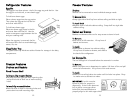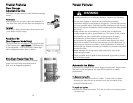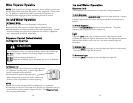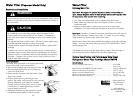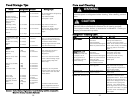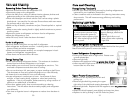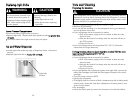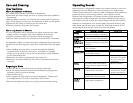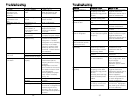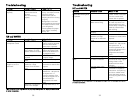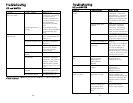
27
FFoooodd SSttoorraaggee TTiippss
FFoooodd SSttoorraaggee CChhaarrtt
Storage times are approximate and may vary depending on type of
packaging, storage temperature, and the quality of the food when
purchased.
DDAAIIRRYY PPRROODDUUCCTTSS
Butter
Milk and cream
Cream cheese,
cheese spread and
cheese food
Cottage cheese
Sour cream
Hard cheese
(Swiss, Cheddar and
Parmesan)
EEGGGGSS
Eggs in the shell
Leftover yolks or
whites
FFRRUUIITTSS
Apples
Bananas
Pears, plums,
avocados
Berries, cherries,
apricots
Grapes
Citrus fruits
Pineapples, cut
1 month
1 week
1 to 2 weeks
3 to 5 days
10 days
1 to 2 months
3 weeks
2 to 4 days
1 month
2 to 4 days
3 to 4 days
2 to 3 days
3 to 5 days
1 to 2 weeks
2 to 3 days
6 to 9 months
Not recommended
Not recommended
Not recommended
Not recommended
4 to 6 months
May become
crumbly
Not recommended
9 to 12 months
8 months (cooked)
6 months
(whole/peeled)
Not recommended
6 months
1 month (whole)
Not recommended
6 to 12 months
Wrap tightly or cover.
Check carton date. Close
tightly. Don’t return unused
portions to original container.
Don’t freeze cream unless
whipped.
Wrap tightly.
Store in original carton. Check
carton date.
Store in original carton.
Check carton date.
Wrap tightly.
Cut off any mold.
Refrigerate small ends down.
For each cup of yolks to be
frozen, add 1 tsp. sugar for use
in sweet, or 1 tsp. salt for non-
sweet dishes.
May also store unripe or hard
apples at 60° to 70° F (16° to
21° C).
Ripen at room temperature
before refrigerating. Bananas
darken when refrigerated.
Ripen at room temperature
before refrigerating. Avocados
darken when refrigerated.
Ripen at room temperature
before refrigerating.
Ripen at room temperature
before refrigerating.
May also store at 60° to 70° F
(16° to 21° C). If refrigerated,
store uncovered.
Will not ripen after purchase.
Use quickly.
FFooooddss RReeffrriiggeerraattoorr FFrreeeezzeerr SSttoorraaggee TTiippss
26
FFoooodd SSttoorraaggee TTiippss
FFrroozzeenn FFoooodd SSttoorraaggee
• The freezer compartment of a refrigerator should be kept at
approximately 0° F (-18° C). To check the temperature, place an
appliance thermometer between the frozen packages and check
after 24 hours. If the temperature is above 0° F (-18° C), adjust the
control as described on page 5.
• A freezer operates more efficiently when it is at least two-thirds full.
PPaacckkaaggiinngg FFooooddss ffoorr FFrreeeezziinngg
• To minimize dehydration and quality deterioration use aluminum
foil, freezer wrap, freezer bags or airtight containers. Force as much
air out of the packages as possible and be sure they are tightly
sealed. Trapped air can cause the food to dry out, change color
and develop an off-flavor (freezer burn).
• Wrap fresh meats and poultry with suitable freezer wrap prior to
freezing.
• Do not refreeze meat that has completely thawed.
LLooaaddiinngg tthhee FFrreeeezzeerr
• Avoid adding too much warm food to the freezer at one time. This
overloads the freezer, slows the rate of freezing and can raise the
temperature of frozen foods.
• Leave space between the packages so cold air can circulate freely,
allowing food to freeze as quickly as possible.
• Avoid storing hard-to-freeze foods such as ice cream and orange
juice on the freezer door shelves. These foods are best stored in
the freezer interior where the temperature varies less with door
openings.
Refer to the Food Storage Chart on pages 27 and 28 for approximate
storage times.




